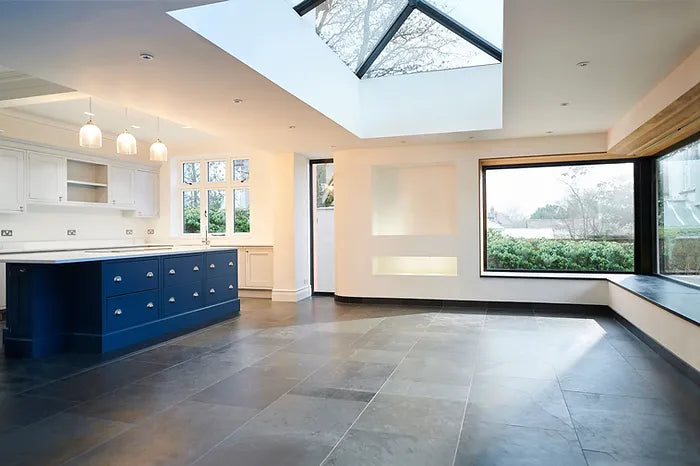
Where Do You Stand on Kitchen Flooring? Choosing the Right Floor for Your Kitchen
Share
Your kitchen floor faces more challenges than any other floor in the house – especially when it is situated at or near a major entrance to the house. It needs to handle spills, stains, heavy traffic, and the occasional dropped pan—all without compromising on style or comfort. We help a lot of clients blend their kitchen flooring with other areas of the home and consider complete replacement quite often. When helping our clients choose the best flooring for their lifestyle, we keep these factors in mind:
-
Durability: The floor must stand up to wear and tear while staying beautiful.
-
Water Resistance: Kitchens are high-moisture zones, making water resistance essential.
-
Ease of Cleaning: Floors should be easy to clean, as spills and crumbs are a daily occurrence.
-
Comfort: Standing in the kitchen requires a floor that offers some cushioning.
-
Aesthetic Appeal: The flooring should complement your kitchen’s design and create a cohesive look…of course.
Premium Vinyl can be a standout choice
Premium vinyl flooring has emerged as one of the best choices for kitchens, offering the perfect combination of style, durability, and affordability. It’s come so far in its appearances over the years and there is an array of options.
Here’s what we like about it:
-
Waterproof Durability - Premium vinyl is 100% waterproof, making it impervious to spills, splashes, and even standing water. Unlike wood, it won’t warp or stain when exposed to moisture, making it a stress-free option for busy households.
-
Stylish Designs - Today’s luxury vinyl flooring comes in a wide range of designs that mimic high-end materials like hardwood and stone. With realistic textures and finishes, you can achieve the look of wood or tile without the upkeep or cost.
-
Easy Maintenance - Vinyl is incredibly easy to clean. Spills wipe up quickly, and regular sweeping or mopping keeps it looking great. Unlike grout in tile floors or refinishing wood, vinyl requires no special treatments.
-
Soft and Comfortable Underfoot - Unlike tile or concrete, vinyl has a slightly cushioned feel, making it more comfortable to stand on for extended periods—a significant advantage for home chefs.
-
Budget-Friendly - While premium vinyl may cost more upfront than standard options, it’s still significantly more affordable than hardwood or stone. Plus, its long lifespan and low maintenance make it a cost-effective choice over time. There are multiple options when it comes to thickness and durability, but in a heavy traffic area and for an active family, we typically try to stick with a 20 MIL flooring for durability. The cost difference is not often significant enough to warrant a lower quality.
-
DIY-Friendly Installation - Many vinyl options come in click-lock planks or peel-and-stick tiles, making installation accessible for handy homeowners. This can save you money on labor costs during a renovation.
Wood Flooring in Kitchens: The Pros and Cons
We get this question a lot! Wood flooring is a timeless and beautiful choice that adds warmth and character to any kitchen. In fact, we have wood flooring in our own kitchen – a very hardy Brazilian Cherry. However, it’s not without its challenges. Let’s put cost aside and just talk about the pros and cons of the wood itself.
The Benefits of Wood Flooring in Kitchens
-
Aesthetic and Versatility - Wood floors are undeniably gorgeous. They bring warmth, texture, and a natural elegance to the space, making kitchens feel cozy and inviting. Available in a wide range of colors, finishes, and plank widths, wood complements nearly any kitchen style, from rustic farmhouse to modern minimalism.
-
Longevity and Value - When properly maintained, wood floors can last for decades, developing a rich patina over time. Wood flooring is a desirable feature that adds value to your home, appealing to potential buyers.
BUT!....there are Risks to consider
-
Water Damage: Wood is highly susceptible to water damage. Prolonged exposure to spills, leaks, or high humidity can cause warping, swelling, or staining. In fact, just this last year we’ve worked with three clients who are replacing their kitchens due to wood flooring damages – granted the kitchens needed to be updated, but the wood floors were the catalyst.
-
Bumps, Bruises and High Maintenance - Kitchens are busy spaces, and heavy pots, chairs, or even pet claws can leave marks on the surface. Wood floors require regular upkeep, including refinishing every few years, to maintain their appearance and durability.
But of course: Tile
Premium Vinyl and wood, despite being two of the more popular we seem to be dealing with, don’t fit everyone’s vision for sure, but there are other great kitchen flooring materials to explore. Concrete and cork options are definitely for the unique homebuyer, but let’s cover the pros and cons of tile, which is a much more common choice:
-
Pros: Extremely durable and water-resistant, with endless design options. Those endless options are potentially a bit less timeless if choosing something on trend. That said, natural stone tiles are both aesthetically pleasing, warm and neutral with regards to style and are much less prone to trends.
-
Cons: Unless you have radiant floor heating, it can be cold and is definitely harder underfoot, making it less comfortable for long periods. It is also much more expensive to remove and replace if the style no longer suits you.
How Flooring Impacts Home Value
The right flooring can significantly enhance the value of your home, especially in a high-traffic area like the kitchen. Modern, well-maintained flooring makes a strong impression on potential buyers. Premium vinyl, for example, offers the look of hardwood or tile at a fraction of the cost, creating a high-end appearance without breaking the budget. Premium vinyl and tile appeal to a much wider audience than wood, making those stand out choices. While hardwood flooring may have the highest ROI in many areas of the home, most homebuyers will consider the practicality and nuisance of the maintenance in a kitchen. A more appealing option like tile or vinyl, especially with an updated kitchen, are likely to be a strong selling point.
Which Floor Is Right for Your Kitchen?
When it comes to kitchen flooring, there’s no one-size-fits-all answer. While premium vinyl offers a winning combination of style, durability, and value, other materials like tile or laminate may better suit your specific needs and budget. Whatever material you choose, remember that kitchen flooring is an investment in both your daily comfort and your home’s future value. A beautiful, functional kitchen floor can make life simpler and how YOU live life in your kitchen (not that of a potential buyer unless you are turning the kitchen around to sell the house) is the most critical factor in the choice. Choose a floor that supports your lifestyle, enhances your design, and adds lasting value to your home.
